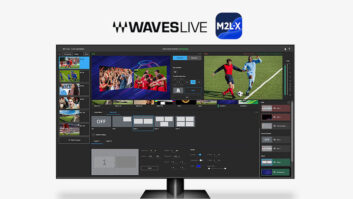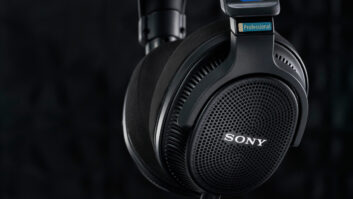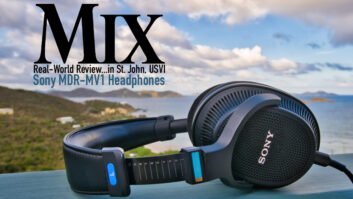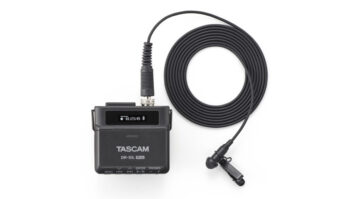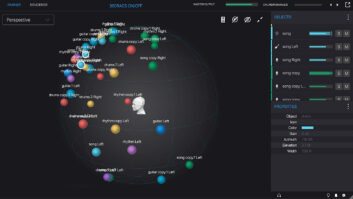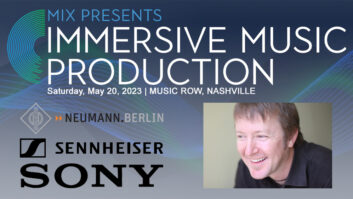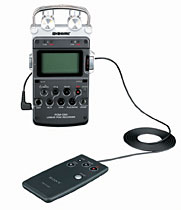

Sony’s new handheld PCM-D50 recorder reprises most of the features and performance of the company’s much-higher-priced PCM-D1 in a smaller-sized unit that’s also “smaller” in price: $599 MSRP. The D1’s titanium case, rechargeable battery system and round mechanical peak meters have been replaced with an all-aluminum enclosure, four AA battery powering and included AC power supply — but essentially the compact version offers the same peak-reading and backlit LCD.
The D50 is about one-third the weight of the D1, yet it retains the same “point-and-capture” design, using a pair of swiveling electret cardioid condenser mics for either 90-degree X/Y stereo or 120-degree wide positioning. The unit also has a powerful headphone output, external mic input, and both analog and optical digital I/O facilities.
THANKS FOR THE MEMORY
The D50 records PCM audio to internal 4GB Flash memory; additional storage becomes possible when you insert a Sony Memory Stick into a slot on the side — only Pro HG Duo™ sticks work. The unit records and plays WAV-format digital audio at 16- or 24-bit depths at 22.05/44.1/48/96kHz sample rates. Audio files can be on/off-loaded to the unit via USB 2 with PC and Mac support, including Leopard 10.5. Also included are a copy of Sound Forge Audio Studio LE editor and a Windows 2000 driver.
The D50 retains both the D1’s stereo limiter — with a choice of three different release times (150 ms, 1 second and 1 minute) — and the great-sounding Digital Pitch Control (DPC), where playback audio speed can be changed from +100 to -75 percent without pitch change. The five-second prerecord buffer function captures audio you’d normally miss if you were late going from Record Pause mode into Record; you’ll never miss the beginning of a song or the first words of a speech.
The D50’s internal recording folder structure has 10 folders capable of holding up to 99 tracks (recorded files) each — 990 total for the internal 4GB Flash memory or any additional Memory Stick. “Pecking” the Menu button displays the folder that is currently in use. This is the first of only two menu layers; here you can search/delete individual files or select other folders. I used a separate folder as an organizational aid for all recordings made at the same sample rate.
WORKING IN THE FIELD
For sonic evaluation, I transferred all field recordings to my Pro Tools rig. Upon connection to the Mac, the D50 shows up as a hard drive, and the Mac’s Image Capture utility allowed off-loading the files right into my Music folder, but you can also drag and drop files anywhere.
For all my recordings, I tried both the X/Y mic position and the wide setting. The former is more mono-compatible and best for single-point source recording such as a lecturer, but for music I found it too narrow sounding. I preferred the wider mic setting in all cases. I recorded an acoustic guitar using close proximity to produce the fattest sound that was not overly bright. The green (-12dB) and red (-1dB) headroom LEDs make it simple to set optimal recording levels; the remaining headroom is always indicated on the LCD screen. The backlit LCD was a bit dim for my taste, but it was perfectly usable in darker rooms.
Without a doubt, the acoustic guitar recording was of studio quality. I used the limiter with 150ms recovery time but not with the -24dB low-cut filter that’s adjustable to either a 75- or 150Hz corner frequency. Both of these processors switch in/out via slide switches on the back of the unit — a nice touch. Setting the low-cut filter, the limiter and other parameters requires diving into the second layer of the LCD menu. Holding the Menu button down reveals where you set sample rate/bit depth, DPC, Super-Bit Mapping (SBM), prerecord buffer, clock and more.
My next recording was 25 feet away from a blues band in a noisy bar. I tried the -20dB pad, but it made setting an exact level a little touchy as compared to using no pad. It would make a nice update to illuminate the record-level knob either by allowing light from the display to spill onto it or by just adding a 1-to-10 indicator in the LCD screen.
As with the acoustic guitar recording, I used 96kHz/24-bit, the limiter, wide mics and no pad, as the resultant recordings were more dynamic sounding without it. The limiter is very gentle and unobtrusive, and it allows for higher average recording levels — I would recommend always using it.
My last recording was for an oral history project at 22.05kHz/16-bit with the limiter at 1-minute recovery, low-cut filter at 75 Hz and wide mics. One mic was pointed at me and the other was pointed at my 95-year-old mother. Later, using BIAS Peak 5 XT stereo editor software, I compressed each channel separately before mixing and posting online. While recording and during subsequent playbacks, I used the unit’s Divide feature to do on-the-fly file splitting to separate each of my mom’s stories into individual files.
AFFORDABLE PORTABLE
Sony’s PCM-D50 provides a wonderful path to pristine digital recording in a self-contained, portable package. It’s nearly idiot-proof and includes a large complement of accessories. There are few tasks — from casual to fully pro — that this unit cannot easily handle and produce excellent results.
Sony Pro Audio, 800/686-7669, www.sony.com/professional.
Barry Rudolph is an L.A.-based recording engineer. Visit him online at www.barryrudolph.com.

LISTEN:
Clip of guitiarist Dean Parks recorded with the mics set to the widest position
LISTEN:
Clip of guitiarist Dean Parks recorded with the mics set to the narrowest position

